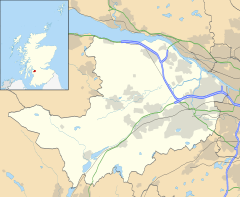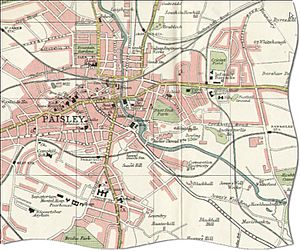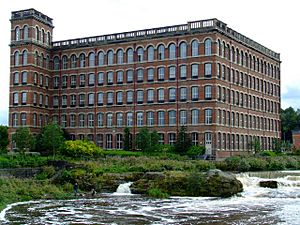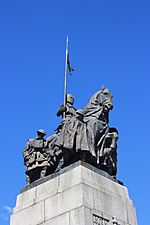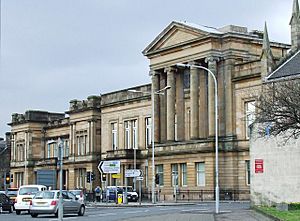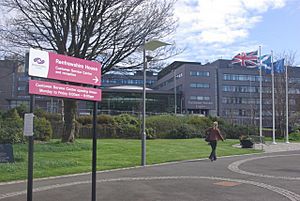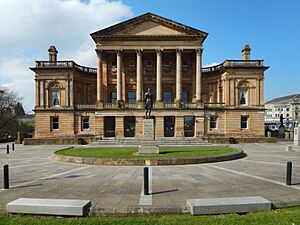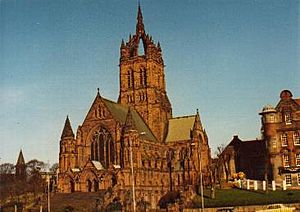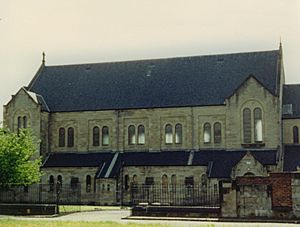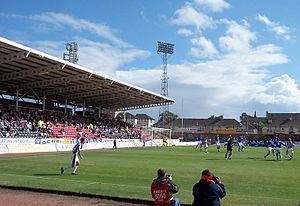Paisley, Renfrewshire facts for kids
Quick facts for kids Paisley
|
|
|---|---|
| Town and administrative centre | |
 Paisley town centre with White Cart Water. Taken from Seedhill. |
|
| Population | 79,369 (2022) |
| OS grid reference | NS485635 |
| • Edinburgh | 49 mi (79 km) E |
| Council area | |
| Lieutenancy area | |
| Country | Scotland |
| Sovereign state | United Kingdom |
| Post town | PAISLEY |
| Postcode district | PA1 – PA3 |
| Dialling code | 0141 & 01505 |
| Police | Strathclyde |
| Fire | Strathclyde |
| Ambulance | Scottish |
| EU Parliament | Scotland |
| UK Parliament |
|
| Scottish Parliament |
|
Paisley (/ˈpeɪzli/ PAYZ-lee; Scots: Paisley; Scottish Gaelic: Pàislig [ˈpʰaːʃlɪkʲ]) is a large town situated in the west central Lowlands of Scotland. Located north of the Gleniffer Braes, the town borders the city of Glasgow to the east, and straddles the banks of the White Cart Water, a tributary of the River Clyde.
Paisley serves as the administrative centre for the Renfrewshire council area, and is the largest town in the historic county of the same name. It is often cited as "Scotland's largest town" and is the fifth largest settlement in the country, although it does not have city status.
The town became prominent in the 12th century, with the establishment of Paisley Abbey, an important religious hub which formerly had control over other local churches. Paisley expanded significantly during the Industrial Revolution as a result of its location beside White Cart Water, with access to the Clyde and nearby ore, mineral and agricultural resources. Factories and mills developed leading to an increase in the town's population. The town's associations with political radicalism were highlighted by its involvement in the Radical War of 1820, with striking weavers being instrumental in the protests.
By the late 19th century, Paisley was a global centre of the weaving industry, giving its name to the Paisley shawl and the Paisley pattern. However, industrial decline followed in the 20th century. By 1993, all of Paisley's mills had closed, although they are memorialised in the town's museums and civic history. The town now functions as a regional centre for local governance and services as well as a residential commuting area within the Greater Glasgow urban region.
Contents
History
Formerly and variously known as Paislay, Passelet, Passeleth, and Passelay the burgh's name is of uncertain origin; some sources suggest a derivation either from the Brittonic word pasgill, "pasture", or more likely, passeleg, "basilica", (i.e. major church), itself derived from the Greek βασιλική basilika. However, some Scottish place-name books suggest "Pæssa's wood/clearing", from the Old English personal name Pæssa, "clearing", and leāh, "wood". Pasilege (1182) and Paslie (1214) are recorded previous spellings of the name. The Gaelic spelling is Pàislig.
Paisley has monastic origins. A chapel is said to have been established by the 6th/7th century Irish monk, Saint Mirin at a site near a waterfall on the White Cart Water known as the Hammils. Though Paisley lacks contemporary documentation it may have been, along with Glasgow and Govan, a major religious centre of the Kingdom of Strathclyde. A priory was established in 1163 from the Cluniac priory at Wenlock in Shropshire, England at the behest of Walter fitz Alan (d. 1177) High Steward of Scotland. In 1245 this was raised to the status of an Abbey. The restored Abbey and adjacent 'Place' (palace), constructed out of part of the medieval claustral buildings, survive as a Church of Scotland parish church. One of Scotland's major religious houses, Paisley Abbey was much favoured by the Bruce and Stewart royal families. It is generally accepted that William Wallace was educated here. King Robert III (1390–1406) was buried in the Abbey. His tomb has not survived, but that of Princess Marjorie Bruce (1296–1316), ancestor of the Stewarts, is one of Scotland's few royal monuments to survive the Reformation.
Paisley coalesced under James II's wish that the lands should become a single regality and, as a result, markets, trading and commerce began to flourish. In 1488 the town's status was raised by James IV to Burgh of barony.
Many trades sprang up and the first school was established in 1577 by the Town Council. The Paisley witches, also known as the Bargarran witches or the Renfrewshire witches, were tried in Paisley in 1697. Seven were convicted and five were executed on the Gallow Green. Their remains were buried at Maxwelton Cross in the west end of the town. This was the last mass execution for witchcraft in western Europe. A horse shoe was placed on top of the site to lock in the evil. A horse shoe is still visible in the middle of this busy road junction today—though not the original. The modern shoe is made of bronze and bears the inscription, "Pain Inflicted, Suffering Endured, Injustice Done".
Industrial Revolution
The Industrial Revolution based on the textile industry turned Paisley from a small market town to an important industrial town in the late 18th century. Its location attracted English mill owners; immigrants from Ayrshire and the Highlands poured in to a town that offered paying jobs to women and children. However, silk fell out of fashion in 1790. The mills switched to the imitation Kashmir (cashmere) shawls called "Paisley." Under the leadership of Thomas Coats (1809-1893), Paisley became the world centre for thread making. The high-status skilled weavers mobilized themselves in radical protests after 1790 culminating in the failed "Radical War" of 1820. Overproduction, the collapse of the shawl market and a general depression in the textile industry led to technical changes that reduced the importance of weavers. Politically the mill owners remained in control of the town.
By the mid-19th century weaving had become the town's principal industry. The Paisley weavers' most famous product were the shawls, which bore the Paisley Pattern made fashionable after being worn by a young Queen Victoria. Despite being of a Kashmiri design and manufactured in other parts of Europe, the teardrop-like pattern soon became known by Paisley's name across the western world. Although the shawls dropped out of fashion in the 1870s, the Paisley pattern remains an important symbol of the town: the Paisley Museum maintains a significant collection of the original shawls in this design and it has been used, for example, in the modern logo of Renfrewshire Council, the local authority.
Politics and relief
Through its weaving fraternity, Paisley gained notoriety as being a literate and somewhat radical town and between 1816 and 1820 became the scene of a Radical War. Political intrigue, early trades unionism and reforming zeal came together to produce mass demonstrations, cavalry charges down the high street, public riots and trials for treason. Documentation from the period indicates that overthrow of the government was even contemplated by some. The weavers of Paisley were certainly active in the 'Radical War'. A mixture of religious opinions and healthy drink-fueled debate raged at night amongst the weavers, poets, merchants, masons and others. The perceived radical nature of the inhabitants prompted the Tory Prime Minister Benjamin Disraeli to comment "Keep your eye on Paisley". The poet Robert Tannahill lived in this setting, working as a weaver. Paisley's annual Sma' Shot Day celebrations held on the first Saturday of July were initiated in 1856 to commemorate a 19th-century dispute between weavers and employers over payment for "sma' shot" – a small cotton thread which, although unseen, was necessary in holding together garments.
A permanent military presence was established in the town with the completion of Paisley Barracks in 1822.
The economic crisis of 1841-43 hit Paisley hard as most of the mills shut down. Among the mill owners, 67 of 112 went bankrupt. A quarter of the population was on poor relief. The Prime Minister, Sir Robert Peel decided to act. He secured additional funds for relief and sent his own representative to the city to supervise its distribution. He convinced Queen Victoria to wear Paisley products in order to popularise the products and stimulate demand.
The American Civil War of 1861-1865 cut off cotton supplies to the textile mills of Paisley. The mills in 1861 had a stock of cotton in reserve, but by 1862 there was large-scale shortages and shutdowns. There were no alternative jobs for the workers, and local authorities refuse to provide relief. Voluntary relief efforts were inadequate, and the unemployed workers refused to go to workhouses. Workers blamed not the United States, but rather the officials in London for their hardship and did not support the idea of war with the United States.
Paisley snail
Paisley was also the site of an incident that gave rise to a major legal precedent. In a Paisley cafe in 1928, a woman allegedly found a dead snail in a bottle of ginger beer, and became ill. She sued the manufacturer for negligence. At the time a manufacturer was considered liable only if there was a contract in place with the harmed party. However, after Donoghue v Stevenson wound through the courts, a precedent was established that manufacturers (and other "neighbours" or fellow citizens) owe a duty not to do foreseeable harm to others by negligence, regardless of contractual obligations, which paved the way for modern tort law. The case is often called the "Paisley snail."
Second World War
Owing to its industrial roots, Paisley, as with many industrial towns in Renfrewshire, became a target for German Luftwaffe bombers during World War II. Although it was not bombed as heavily as the nearby Glasgow (see Clydebank Blitz), air raids still occurred periodically during the early years of the war, killing nearly a hundred people in several separate incidents; on 6 May 1941, a parachute mine was dropped in the early hours of the morning claiming 92 victims and is billed the worst disaster in Paisley's history. The Gleniffer Braes, situated on the outskirts south of Paisley, is home to a number of "decoy ponds" (mock airfields) used by the RAF in the aftermath of the Battle of Britain as part of a project code-named "Starfish Decoy" designed to confuse German spies.
Governance
Paisley is the administrative centre for the council area of Renfrewshire Council, and also lies within the registration county of the same name. The town is divided into Community Councils for representation at the most local level.
Paisley in represented in the Scottish Parliament by George Adam MSP, who holds the Paisley seat. For the House of Commons of the United Kingdom the town is divided between two constituencies covering the whole of Renfrewshire: Paisley and Renfrewshire North (Alison Taylor MP) and Paisley and Renfrewshire South (Johanna Baxter MP).
Public services
Paisley lies within the Renfrewshire and Inverclyde Division of the Scottish police service and is one of three Area Commands in that division. Paisley is divided into five community policing areas: Paisley North-west (incorporating Glasgow Airport); Paisley South-west; Paisley East and Ralston; Paisley South; Gallowhill (as part of Renfrew and Gallowhill). Gallowhill is covered by the Renfrew Area Command. For judicial purposes, the area forms part of the sheriffdom of North Strathclyde and public prosecutions are directed by the Procurator Fiscal for Argyll and Clyde.
NHS Greater Glasgow and Clyde is the National Health Service Board serving Paisley and the town's main hospital with accident and emergency facilities is the Royal Alexandra Hospital. Strathclyde Fire and Rescue is the statutory fire and rescue service covering Paisley, with one community fire station on the town's Canal Street.
Water and sewerage is provided in Paisley by Scottish Water, a public body, and water and sewerage charges are collected alongside council tax by Renfrewshire Council, the local authority, on its behalf. Renfrewshire Council is also responsible for the provision of waste management in the area. Paisley's distribution network operator, the organisation licensed to transmit electricity from the National Grid to consumers, is Scottish Power.
Geography and climate
 |
Renfrew |  |
||
| Elderslie | Glasgow | |||
| Barrhead |
Geography
Paisley sits primarily on an expanse of low ground around 12 metres (40 ft) above sea level surrounding the White Cart Water, which runs through the town centre. There are some hills and ridges which have been absorbed as the town has expanded. The settlement is historically centred on Oakshaw, an area surrounding a hill to the north of the current High Street. Oakshaw is a conservation area, and on the high ground many of Paisley's significant buildings can be found, such as the High Kirk, the Coats Observatory and the former John Neilson Institution, which was once a school and is now converted into residential flats.
Paisley expanded steadily, particularly in the Victorian and Edwardian eras, creating many suburbs. Castlehead is a wooded conservation area primarily made up of Victorian villas where many of the town's leading industrialists made their homes in the late 19th century. Thornly Park is another conservation area, to the south of the town, just off Neilston Road toward Barrhead. It contains a variety of architecture ranging from mock Tudor to Art Deco. Many of the houses were designed by W. D. McLennan, a contemporary of Charles Rennie MacIntosh. McLennan also designed several local churches such as St Matthew's Church.
Particularly following the Housing Act 1946, modern Paisley grew into the surrounding countryside, and several large residential areas were created in the post-war period. These include portions of Glenburn (south), Foxbar (south west), Ferguslie Park (north west), Gallowhill (North East) and Hunterhill (South East). Gockston in the far north of the town has many terraced houses, and after regeneration has many detached and semi-detached houses as well as several blocks of flats. Dykebar, to the south east of the town centre, is a residential area which is also the site of Dykebar Hospital, a secure psychiatric hospital. Local parks include Fountain Gardens and Barshaw Park.
On the outskirts of the town are a number of settlements such as Ralston, a residential area in the far east bordering the city of Glasgow. Ralston was outside the Paisley burgh boundary when constructed in the 1930s, but as a result of local authority reorganisation in the 1990s, it is now a suburb of Paisley.
Climate
| Climate data for Paisley, elevation: 16 m or 52 ft, 1981–2010 normals, extremes 1959–present | |||||||||||||
|---|---|---|---|---|---|---|---|---|---|---|---|---|---|
| Month | Jan | Feb | Mar | Apr | May | Jun | Jul | Aug | Sep | Oct | Nov | Dec | Year |
| Record high °C (°F) | 13.5 (56.3) |
14.4 (57.9) |
17.2 (63.0) |
24.4 (75.9) |
26.5 (79.7) |
29.6 (85.3) |
30.0 (86.0) |
31.0 (87.8) |
26.7 (80.1) |
22.8 (73.0) |
17.7 (63.9) |
14.1 (57.4) |
31.0 (87.8) |
| Mean daily maximum °C (°F) | 6.9 (44.4) |
7.4 (45.3) |
9.6 (49.3) |
12.6 (54.7) |
15.9 (60.6) |
18.1 (64.6) |
19.7 (67.5) |
19.2 (66.6) |
16.4 (61.5) |
12.7 (54.9) |
9.4 (48.9) |
6.9 (44.4) |
12.9 (55.2) |
| Daily mean °C (°F) | 4.4 (39.9) |
4.6 (40.3) |
6.3 (43.3) |
8.7 (47.7) |
11.6 (52.9) |
14.1 (57.4) |
15.9 (60.6) |
15.5 (59.9) |
13.1 (55.6) |
9.7 (49.5) |
6.7 (44.1) |
4.3 (39.7) |
9.6 (49.3) |
| Mean daily minimum °C (°F) | 1.8 (35.2) |
1.8 (35.2) |
3.0 (37.4) |
4.8 (40.6) |
7.3 (45.1) |
10.1 (50.2) |
12.0 (53.6) |
11.7 (53.1) |
9.7 (49.5) |
6.7 (44.1) |
4.0 (39.2) |
1.7 (35.1) |
6.2 (43.2) |
| Record low °C (°F) | −14.8 (5.4) |
−7.5 (18.5) |
−8.3 (17.1) |
−4.4 (24.1) |
−1.1 (30.0) |
1.5 (34.7) |
3.9 (39.0) |
2.2 (36.0) |
−0.2 (31.6) |
−3.5 (25.7) |
−6.8 (19.8) |
−14.5 (5.9) |
−14.8 (5.4) |
| Average rainfall mm (inches) | 148.2 (5.83) |
104.6 (4.12) |
112.3 (4.42) |
63.6 (2.50) |
67.5 (2.66) |
66.4 (2.61) |
73.0 (2.87) |
92.5 (3.64) |
112.5 (4.43) |
143.1 (5.63) |
126.4 (4.98) |
135.2 (5.32) |
1,245.3 (49.01) |
| Average rainy days (≥ 1.0 mm) | 17.3 | 13.2 | 14.9 | 11.6 | 11.9 | 11.1 | 12.0 | 12.8 | 13.8 | 16.8 | 16.0 | 15.5 | 167.0 |
| Mean monthly sunshine hours | 37.6 | 66.9 | 98.6 | 134.5 | 180.1 | 158.9 | 154.3 | 146.8 | 114.9 | 85.2 | 54.0 | 33.1 | 1,265 |
| Source 1: Met Office | |||||||||||||
| Source 2: KNMI/Royal Dutch Meteorological Institute | |||||||||||||
Economy
Public sector organisations in Paisley include the headquarters of Renfrewshire Council, the largest campus of the University of the West of Scotland, the Paisley campus of West College Scotland and the Royal Alexandra Hospital.
Glasgow Airport, located on the northern edge of Paisley, is also a significant employer and part of the area's transport infrastructure. The airline Loganair's registered office is located within the airport complex.
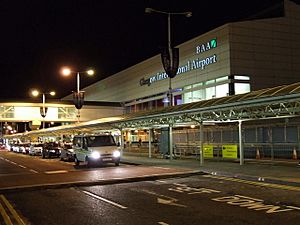
Scotch whisky blenders and bottlers Chivas Brothers, now a subsidiary of Pernod Ricard, are also located in the town.
The site of the former Rootes/Chrysler/Talbot on the western outskirts of the town is now home to Phoenix Retail Park. Numerous private developers have invested, creating various retail outlets, vehicle showrooms, restaurants, a cinema complex, hotel and a business centre.
Landmarks
Civic buildings
As the administrative centre of the county of Renfrewshire, Renfrew District and, currently, Renfrewshire council area, Paisley is home to many significant civic buildings. Paisley Town Hall, adjacent to the Abbey, was funded by the will of George Aitken Clark, one of the Clark family, owners of the Anchor Mills. In competition, Sir Peter Coats funded the construction of the modern Paisley Museum and Central Library (1871), also in a neo-Classical style. The Clarks and Coats families dominated Paisley industry until their companies merged in 1896. Renfrewshire's former County Buildings, Police Station and Jail on County Square were demolished in 1821, and the County Council then met in a newer neo-classical building, completed in 1890, which now houses Paisley Sheriff Court.
Renfrewshire House, the modern headquarters of Renfrewshire Council, was constructed as Paisley Civic Centre. Designed by Hutchison, Locke and Monk following a competition, the building was designed to house offices of both the county and town councils. It was intended to become a civic hub for Paisley but the absence of any shops and non-council premises prevented this from happening. It became the home of the Renfrew sub-region of Strathclyde Regional Council in 1975 and of Renfrewshire Council in 1996. It is listed by the conservation organisation DoCoMoMo as one of the sixty key Scottish monuments of the post-war period.
Other civic buildings of interest include the Russell Institute, an art deco building constructed in 1926.
Religious sites
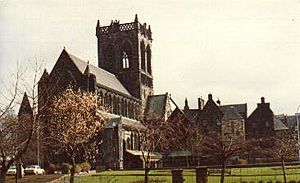
Most noticeable among the buildings of Paisley is its medieval Abbey in the centre of the town dating from the 12th century. The earliest surviving architecture is the south-east doorway in the nave from the cloister, which has a round arched doorway typical of Romanesque architecture which was the prevalent architectural style before the adoption of Gothic. The choir (east end) and tower date from the late 19th and early 20th centuries and are examples of Gothic Revival architecture. They were reconstructed in three main phases of restorations with the tower and choir conforming to the designs of Dr Peter MacGregor Chalmers. The roof in the nave is the most recent of restorations with the plaster ceiling by Rev Dr Boog which was added in the 1790s being replaced by a timber roof in 1981.
Former Thomas Coats Memorial Baptist Church, named for the industrialist Thomas Coats (1809–1883), is an example of Gothic Revival architecture. It dominates the town's skyline with its crown spire more than 60 m (197 ft) high. Opened in 1894 and designed by Hippolyte Jean Blanc it was the largest Baptist church in Europe. The exterior is made of old red sandstone. Inside, the church is decorated with wood carvings, mosaic floors and marble fonts. The church also contains a 3040 pipe Hill Organ.
The St Mirin's Cathedral in Incle Street is the seat of the Catholic Bishop of Paisley. The church was completed in 1931 to replace an earlier building, in nearby East Buchanan Street, which dated from 1808. The original St Mirin's church was the first Catholic church to be built in Scotland since the Reformation. With the erection of the Diocese of Paisley in 1947 the church was raised to cathedral status.
St Matthew's Church (Church of the Nazarene) at the junction of Gordon Street and Johnston Street is Art Nouveau in style. Designed by local architect William Daniel McLennan, a contemporary of Charles Rennie Mackintosh, it was built in 1905–07.
Other
Dating from circa 1160 Blackhall Manor is the oldest building in Paisley. It was given to the Burgh of Paisley by the Shaw-Stewart family in 1940, but was threatened with demolition in 1978. It was privately purchased in 1982 and fully restored as a private dwelling.
As a result of its historic textile industry, Paisley has many examples of Victorian industrial architecture. Most notable is the Category A listed Anchor Mills, built in 1886. The building was converted in 2005 into residential flats. Textiles have a longer history in Paisley, represented by the Sma' Shot cottages complex on Shuttle Street: a small public museum of weaving from its 18th-century origins as a cottage industry.
Another landmark connected with the textile industry is the Dooslan Stane or Stone. The stone was a meeting place of the Weavers Union in the south of Paisley; it was also used as a "soapbox" and was originally inscribed with its history (now largely faded). It was moved from its original site at the corner of Neilston Road and Rowan Street to its present location in Brodie Park. Also present, arranged around the Dooslan Stane, are the four original Paisley Tolbooth stones. The Dooslan Stane is still used today as the congregating point for the annual Sma' Shot parade which takes place on the first Saturday in July.
The High Street drill hall was completed in about 1896.
The composer Thomas Wilson's 1988 work Passeleth Tapestry (later his Fourth Symphony) commemorates the history of Paisley in a single 30-minute movement. Commissioned by Renfrew District Council to mark Paisley's 500th anniversary as a burgh of barony, it was premiered on 6 August 1988 in Paisley Abbey with the Royal Scottish National Orchestra under Bryden Thomson. It was subsequently recorded by the Royal Scottish National Orchestra with conductor Rory Macdonald on the Linn Record Label, and received critical acclaim by the Gramophone, which considered its orchestration as "beguiling", but the string glissandos as "kitsch".
Transport
Paisley is connected to the motorway network and the National Rail network, and contains Glasgow Airport within its boundaries.
Paisley is connected by road to the UK motorway network, with the M8 running along the northern edge of the town, Junctions 27, 28 and 29 providing access to Greenock to the west and Glasgow to the east. This forms part of the unsigned E05 Euroroute from Greenock to Gibraltar. Many major A roads converge through the town, including the A726, A737 and A761. The Strathclyde Partnership for Transport, a public body, has direct operational responsibilities covering the area, such as supporting (and in some cases running) local bus services in Paisley (Graham's Bus Service) and across Strathclyde.
The town has four railway stations and is linked by rail to Glasgow city centre as well as Inverclyde and the Ayrshire coast. Paisley Gilmour Street is the largest of the stations and is also the fourth busiest train station in Scotland. There are also smaller stations at Paisley St James, Paisley Canal and Hawkhead. The rail links also connect to Glasgow Prestwick International Airport and ferry routes to Dunoon, the Isle of Arran, Isle of Bute and Northern Ireland. Over the years there have been thirteen railway stations in Paisley and three rail lines that are now closed (The Paisley and Barrhead District Railway, the Barrhead Branch of the GSWR, and the Paisley and Renfrew Railway). Paisley Canal station and the Paisley Canal Line owe their names to the Glasgow, Paisley and Johnstone Canal which occupied the route of the line until 1885, when it was filled in. The line reusues part of the Paisley Canal, which was the site of the Paisley canal disaster in 1810.
Glasgow Airport, operated by AGS Airports, is Scotland's largest airport, located to the north of Paisley at Abbotsinch. It is adjacent to the M8 motorway and served by buses from Paisley Gilmour Street railway station. The planned Glasgow Airport Rail Link project, which was to run through Paisley, was abandoned in 2009. As mentioned above, Glasgow Prestwick Airport in Ayrshire is directly accessible by rail from Paisley Gilmour Street station.
Education
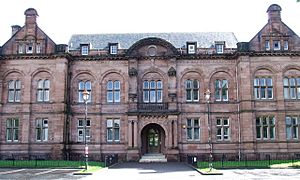
Paisley is the main site for the modern University of the West of Scotland, which was created from a merger between the University of Paisley and Bell College in Hamilton, South Lanarkshire. The University of Paisley was granted university status in 1992, having existed previously as a central institution known as Paisley College of Technology. The further education college West College Scotland has a campus in the town; this institution was previously known as Reid Kerr College.
There are currently four comprehensive state secondary schools in Paisley: Paisley Grammar School, Castlehead High School, St Andrew's Academy, Paisley and Gleniffer High School. The oldest of these is Paisley Grammar which was founded in 1576 and was one of two former grammar schools in the town – alongside the former John Neilson Institution (latterly John Neilson High School) founded in 1852. Other former secondary schools in the area include Merksworth High School (to the north west of the town), St Mirin's Academy or High School (on the west side of the town), St Aelred's High School and Stanely Green High School (both on the south side of the town). Of the current secondary schools in the town, all are non-denominational save for St Andrew's Academy which is a Roman Catholic school.
Religion
Paisley is home to a number of religious denominations and is an important historical centre for the Christian faith in Scotland. The town's historic patron saint is Saint Mirin (or Mirren); according to legendary accounts, Mirin settled in Paisley as a missionary sent from Ireland in the 6th century and was instrumental in bringing the relics of St Andrew to Scotland. Paisley Abbey, one of the towns most significant landmarks, was constructed as a priory in the 12th century and raised to abbey status in the 13th. It served as an ecclesiastical centre for a wide area surrounding the county of Renfrewshire for centuries until the Reformation when such religious centres were reduced to the status of parish churches. For the Church of Scotland, Paisley forms part of the Presbytery of Greenock and Paisley in the Synod of Clydesdale (see: Church of Scotland synods and presbyteries).
Other Christian communities have a number of churches in Paisley, many of which were the result of the Industrial Revolution where people from around the British Isles came to Paisley for work. The Roman Catholic Diocese of Paisley, created in 1947, is centred upon the town's St Mirin's Cathedral, the seat of the Bishop of Paisley. Paisley also forms part of the Episcopalian (Anglican) Diocese of Glasgow and Galloway with its main facilities being contained at the Holy Trinity and St Barnabas Church in the town centre, a congregation which united in 2004. There are currently two Baptist congregations in Paisley: in addition to Thomas Coats Memorial Baptist Church (see under "Landmarks - religious sites") is Central Baptist Church, which meets in nearby Lady Lane. Paisley is home to a meetinghouse of the Church of Jesus Christ of Latter-day Saints located on Glenburn Road.
Other smaller religious groups exist in the town. The Methodist Church of Great Britain has a church and central hall opposite Paisley Abbey which forms part of the Ayrshire and Renfrewshire Circuit. The Christadelphians meet in a hall on Alice Street.
Media
Paisley has one local daily newspaper, the Paisley Daily Express, which is owned by the Trinity Mirror Group. Various local radio stations have operated at times, including Q96 from 1992 to 2007 – serving the Renfrewshire area, although for a considerable period based in neighbouring Glasgow. Its replacement, Glasgow-based Guardian Media Group station 96.3 Rock Radio carries Renfrewshire focused material. In October 2011 Rock Radio, faced with falling advertising revenue, was rebranded by Guardian Media Group as Real Radio XS after a proposed management buyout failed to materialise. Paisley has two local radio stations, Paisleyradio.com broadcasts from the centre of Paisley with a large online audience. Paisleyradio.com won the Prestige Scotland Radio Station of the Year award 3 times 2021/22, 2022/23 and 2023/24. In 2023 paisleyradio.com officially became the most successful radio station from Paisley with 8 media awards. Paisley FM broadcasts from the Grammar School, it covers Paisley, Renfrew and Johnstone.
Sport
St Mirren F.C. is Paisley's sole professional association football team. As of 2018, it plays in the Scottish Premiership. In 2009, the team moved from their Love Street stadium to a new 8,029 capacity stadium, known formally as St Mirren Park, on Greenhill Road. The stadium was later renamed as The Paisley 2021 Stadium to mark the town's bid to be UK City of Culture in 2021. St Mirren last won the Scottish Cup on 16 May 1987. The club won the Scottish League Cup for the first time in its history on 17 March 2013. Another professional football team, Abercorn F.C., was based in Paisley until its decline and liquidation in 1920.
St Mirren Basketball Club was formed in 1997: they have won the National League title once, in 2000, and have won the Scottish Cup three times (1999, 2002 and 2012).
Paisley RFC is an amateur rugby union club based at the Anchor Recreation Grounds in Paisley.
Kelburne Hockey Club is a local club which was founded in 1969.
Notable people
Historically, Paisley was notable as the religious home of the Stewart family who descended from Walter FitzAlan, the first High Steward of Scotland and founder of Paisley Abbey, eventually becoming the Scottish and British Royal Family. The Stewarts once resided at a castle in nearby Renfrew. All six of the High Stewards are buried in the Abbey, as is Marjorie Bruce – the eldest daughter of Robert I of Scotland (Robert the Bruce) – who married the 6th High Steward, thus founding the Stewart dynasty. The first Stewart King of Scotland and son of Marjorie Bruce and Walter Stewart, Robert II, is believed to have been born in the Abbey. His son Robert III is buried there.
Ronald Reagan's maternal great-great-grandparents, Claude Wilson and Margaret Downey, were married at Paisley High Church on 23 May 1807.
Other notable people associated with Paisley include:
Arts and media
- John Amabile (interior designer)
- Claire Barclay (artist)
- Seán Batty (STV weatherman)
- John Bell (actor)
- Gerard Butler (actor)
- John Byrne (artist and playwright)
- Tom Conti (actor)
- Kari Corbett (actress)
- Nick Currie (singer/songwriter, journalist)
- Whisky David (1947–2011) (musician and singer/songwriter)
- Jim Dewar (musician and singer/songwriter
- Joe Egan (musician and songwriter)
- Anya Gallaccio (artist)
- Alexander Gardner (photographer)
- Alexander Goudie (artist)
- Fergus Hall (painter, illustrator, educator)
- William Hart (artist)
- Thomas Kibble Hervey (poet and critic)
- John Hutchison, (architect)
- Thomas S. Tait (architect)
- Kenny Ireland (director and actor)
- Vince Jones (Australian jazz singer, songwriter, and trumpet, flugelhorn and flumpet player)
- Graeme Kelling (1957–2004) (musician from pop group Deacon Blue)
- Patricia Leitch (children's author)
- Phyllis Logan (actor)
- Paul McGillion (actor)
- Neve McIntosh (actress)
- Fulton Mackay (actor)
- Kenneth McKellar (tenor)
- James McMillan (author and historian)
- Ron McMillan (photojournalist and novelist)
- Denzil Meyrick (writer/businessman)
- Kelly Marie (singer)
- Steven Moffat (screenwriter)
- Brendan Mullen (author/nightclub owner)
- Andrew Neil (journalist and television presenter)
- Hector Nicol (singer, comedian and actor)
- Paolo Nutini (singer/songwriter)
- Alan Orr (actor/musician)
- Ebenezer Picken (poet and songwriter)
- Gerry Rafferty (musician and singer/songwriter)
- John Reid (impresario)
- Albert Rossi (musician/drummer)
- David Sneddon (singer/songwriter)
- Alexander Stoddart, Her Majesty's Sculptor in Ordinary in Scotland
- Robert Tannahill (1774–1810) (poet)
- Paul Telfer (actor)
- David Tennant (actor)
- Tom Urie (actor/musician)
- Alexander Wilson (poet, ornithologist)
- Mark Rowley (actor)
Business
- David Eccles (businessman)
- John Glassford (tobacco lord)
- Fred Goodwin, (banker)
- Tirath Khemlani, banker
- Andrew Millar (18th-century bookseller)
- Nora Senior (businesswoman)
- Trevor Sorbie (hairdresser)
Science and education
- Agnes Barr Auchencloss (medical officer)
- Archibald Barr (scientific engineer)
- Robert Broom (palaeontologist)
- Iain Boyd (aerospace engineer)
- Ronald Ian Currie (oceanographer)
- James Goodfellow (Inventor; ATM and PIN)
- David Stow (educationalist)
- James Finlay Weir Johnston (scientist and educationalist)
Sport
- Robert Archibald (basketball player, only scottish citizen to play in the NBA)
- Archie Scott Brown (racing driver)
- Jack Carlin (cyclist)
- Owen Coyle (footballer)
- Gordon Durie (footballer)
- Tom Forsyth (footballer)
- Paul Gallacher (footballer)
- Archie Gemmill (footballer)
- James Grady (footballer)
- Dale Greig (holder of the women's world record for the marathon in 1964)
- Majid Haq (Scottish international cricketer, all time leading Scottish wicket taker as of 2015)
- Omer Hussain (cricketer)
- Hamza Tahir (cricketer)
- Callum Hawkins (athlete)
- David Hay (footballer)
- Paul Lambert (footballer)
- Barry Lavety (footballer)
- Jamie Langfield (footballer)
- Hugh Lorimer (footballer)
- Marc McAusland (footballer)
- Derek McInnes (footballer)
- Micky Mellon (footballer and Oldham Athletic manager)
- Charlie Mitchell (footballer)
- Campbell Money (footballer)
- Robbie Neilson (footballer)
- Brian O'Neil (footballer)
- Lee Peacock (footballer)
- Mark Ralph (Scottish international hockey player)
- Kay Lee Ray (professional wrestler)
- Bernie Slaven (footballer)
- Brian Smith (Olympic cyclist)
- Alasdair Strokosch (Scottish international rugby player)
- Angela Taylor (Great Britain international ice hockey player)
- Elaine Vassie (rugby coach)
Military
- John James Snodgrass (Battle of Waterloo)
- Samuel Evans recipient of the Victoria Cross (Crimean war hero)
- John Hannah recipient of the Victoria Cross (RAF sergeant)
- Arthur HendersonC recipient of the Victoria Cross (army captain)
- Hugh McIver recipient of the Victoria Cross (Army private)
- James McKechnie recipient of the Victoria Cross (army sergeant)
- Archie McKellar (Battle of Britain ace)
International relations
Paisley is twinned with:
- Fürth, Germany, since 1969
- Gladsaxe, Denmark, since 1990
See also
 In Spanish: Paisley para niños
In Spanish: Paisley para niños


